The fact is 80% of people never get past the headline. And that’s why you have to write a blog intro that grabs your readers’ attention and pulls them in right from the start.
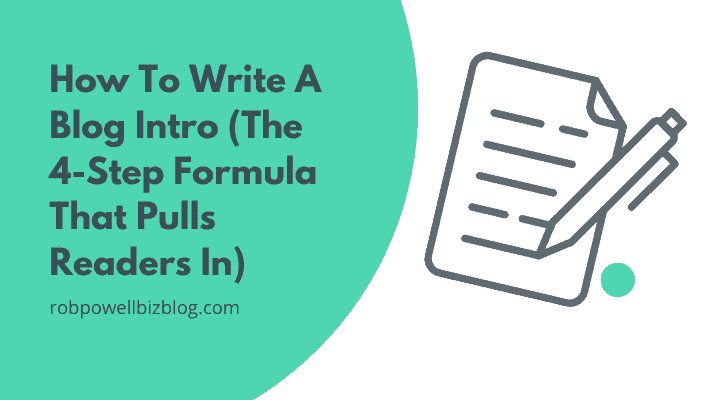
In this article I’ll show you the four-step formula that expert bloggers use to suck their readers in like a Dyson vacuum cleaner.
How Does an Intro Work?
A good blog intro is like a piece of magic.
But you could watch that magic trick a hundred times and still not understand how it’s done.
To understand it and do it yourself, you need to go behind the scenes.
And that’s what I did.
I sat down and analyzed the blog intros of over 50 successful blog posts by well-known writers, including such masters of the compelling intro as John Morrow, Brian Dean, Sonia Simone, and Derek Halpern. I wanted to understand exactly how they do it.
And what I discovered is this: most compelling blog intros use a simple four-step formula.
The Structure of a Compelling Intro
To write a blog intro that pulls your readers in, you need four key elements:
- The Hook
- The Problem
- The Solution
- The Promise
Let’s look at each of these four elements.
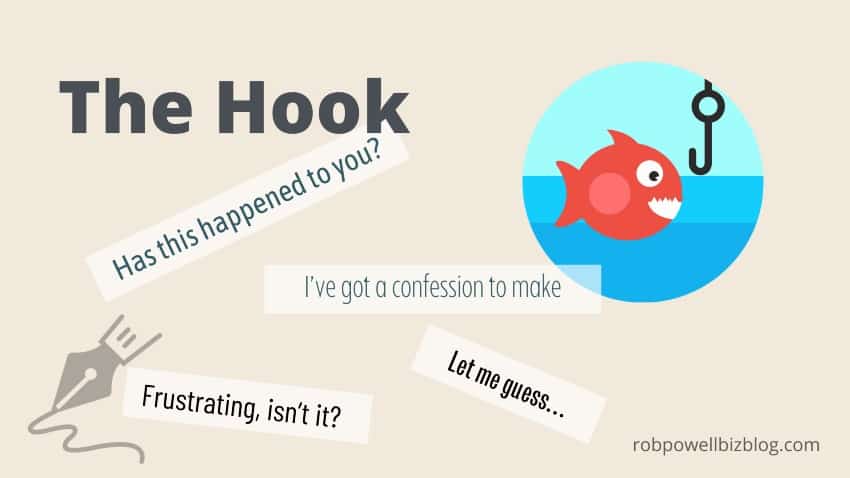
#1 . The Hook
The hook is the opening line of your article. It’s the most important part of your introduction because you literally have only 3 seconds while your reader decides whether to stay or move on.
And that’s why I’ve devoted most of this article to the hook. This is the key to writing a compelling blog intro
Here are 15 types of hooks that work well and pull your reader in right from the start.
Ask a question
A question is an excellent hook because it demands a response. It sets up an unfinished dynamic – you can’t leave it without seeing the response.
Here are some examples:
Has this happened to you? You spend hours writing a post, wracking your brains for the best ideas and then crafting your words on the page. And then it falls flat
Mary Jaksch
Have you ever wished you could peer inside the mind of one of the greatest writers in the world and find out exactly what makes them tick?
(John Morrow).
But there are some questions that don’t require a response. These are also very effective because they are actually making a statement:
What is it with interviews? All the top bloggers seem to do them
(Leanne Regalla)
How the heck do they do it? How do your favorite bloggers attract so many gung-ho, drum-thumping followers?
(Katherine Di Cerbo)
Know what’s tougher than creating great content? Creating it at scale.
(Glen Long)
You know you’re in a war, right? Ok, so no actual guns or tanks are involved, but you are indeed in a bloody battle for the eyes and minds of your readers.
(Gary Korsiko)
Ever notice how some blogs seem to arrive out of nowhere? A few months earlier, you’d never even heard of the blog.
(Brian Dean)
Then there are the intro questions that only have one answer. They pull readers in because the answer is always going to be ‘Yes’:
Want to take your blog to the next level?
(Aaron Lee)
Want to maximize sharing of your content on Facebook?
(Dan Zarella)
Make a confession
A confession is another powerful hook. It intrigues us – what terrible thing are they going to admit?:
I’ve got a confession to make: I love reading about business owners who went broke…
(Derek Halpern)
Can I tell you my worst nightmare?
(Jon Morrow)
Blogging has been very good to me over the last twelve and a half years, but it’s come at a personal cost that I’m sure many can relate to.
(Darren Rowse)
Before I became an inbound marketer, I once made $50,000 a month spamming Google.
(Jeff Deutsch)
OK, confession time — when I was a kid I was a…
(Sonia Simone)
Get inside your reader’s head
This is another good way to start a blog intro. It works well as a hook because it seems to get right inside the reader’s head:
Frustrating, isn’t it? You work tirelessly on your content – but no one reads it.
(Imran Esmail)
Let me guess… At least one of your New Year’s resolutions relates to your writing.
(Glen Long)
Annoying as hell, isn’t it? When a guy who launched his first blog a couple of months ago is already getting dozens of comments and hundreds of shares anytime he posts something new.
(Will Hoekenga)
Admit it. You’ve thought about writing an e-book. In fact, you’ve already imagined the front cover.
(Ali Luke)
Strange feeling, isn’t it? Both exciting and terrifying at the same time. But that’s what it’s like, starting an online business.
(Blaine Wilkerson)
A troubling thought, isn’t it? You’re slaving away at your blog, but you can’t help wondering if you have a shot in hell of getting anyone to read it.
(Jon Morrow)
Don’t try to deny it; you’d love to write a book. In fact, you’ve been dreaming about it so much you can visualize it.
(Cathy Presland)
Make an assumption
Another way to write a blog intro is to assume something about your reader. It works because it makes the reader feel you know them and understand where they are:
No doubt you’ve seen them. The eye-catching posts that promise to reveal the 5, or 10 or even 57 WordPress plugins you absolutely must use on your blog.
(Adam Connell)
You’ve seen it… over, and over, and over again. “The only thing readers read are the headlines.”
(Aaron Orendorff)
You’ve heard the advice a million times, right? “To write better, study the writing of other great writers.”
(Shane Arthur)
I think you’ll agree with me when I say: It’s REALLY hard to convert ice-cold traffic into email subscribers. Or is it?
(Brian Dean)
As a marketer, you know the importance of strong search engine rankings.
(Adam Connell)
Break some bad news
This works well as a hook because we’re all primed to hear bad news (from the doctor, from the boss, from the taxman):
Blogging is hard. You’re forced to wear many hats—writer, editor, promoter, social media manager, even an accountant.
(Andy Libunao)
Getting traffic to your blog is a lot of work. In fact, more work than you ever imagined.
(Chelsea Baldwin)
Can I be painfully honest with you for a moment?
(Jon Morrow)
Be controversial
Another good way to write a blog intro is to be controversial.
There’s so much copy-cat content out there that people find it refreshing when they see a contradictory point of view.
It tells the reader that you’re a maverick, a free-thinker, a thought leader, someone with a fresh point of view, an expert:
Some people tell you that a story always needs to have a point, but I disagree. Contrary to popular belief, you don’t need to quit your day job to start your own business.
(Jon Morrow)
So many online marketers and web designers will recommend that ‘every business should have a Facebook page’ but I disagree.
(Eva Pettifor)
Contrary to popular belief, Lorem Ipsum is not simply random text. It has roots in a piece of classical Latin literature from 45 BC, making it over 2000 years old.
(Unknown)
Can I be straight up with you? 95% of the advice on the web about how to increase your website traffic is totally useless.
(Jon Morrow)
Contrast pain and pleasure
As part of the human condition, we’re all trying to avoid pain and maximize pleasure.
Those are the two parameters that guide every decision we make. So if you put those two things together in your opening sentence, it’s going to grab your reader’s attention:
Building your personal brand can lead to fame and fortune or it can cost you years of wasted time.
(John McDougall)
Use paired opposites
Paired opposites are a basic pattern of human thought. For example: ‘good/bad’, ‘right/wrong’, ‘light/dark’, ‘winner/loser’ etc. That’s why this is another effective way to write a blog intro: it taps into a universal thought pattern.
There are two ways to go about business. The first is to have an idea and then frantically do a lot of stuff hoping some of it works.
(Sonia Simone)
There are two ways to build a profitable blog: You spend years hoping that one day you’ll finally get enough traffic to make money with ads and sponsored posts, or you join thousands of modern bloggers making money right from the get-go
(Girl Chases Dreams)
Make a shocking statement
Another good way to write a blog intro is to use surprise. Stop the reader in their tracks!
Nothing does that better than a shocking statement:
I once wrote a newspaper story that killed a man.
(Julie Neidlinger)
We’ve been telling you there’s no great secret to search optimization, but that’s kind of a lie, isn’t it?
(Sonia Simone)
Could it really be possible that almost everything you are doing to promote your website is a waste of time?
(Jon Morrow)
State a startling fact
We all love facts. Maybe because it makes us feel we became a bit smarter in less than a second. Whatever the reason, opening with a fact will draw your reader in:
In 1995, authors, experts, and influencers sold $10 million worth of eBooks through Amazon. 18 years later that number has grown to $1.6 billion.
(Jeff Bullas)
Make a statement your reader agrees with
This hook works well because when you state something that your reader agrees with, your visitor thinks “That’s exactly right – I need to keep reading”:
I think you’ll agree with me, it’s a constant struggle to engage your blog readers with new and interesting content.
(Martin Nikleva)
I think you’ll agree with me when I say that building a start-up is hard.
(Bill Wilson)
Show empathy
Whenever you open with a statement that resonates with your reader, you’ve hooked them because you seem to have a special insight into their problems:
Raise your hand if you’re a new blogger and you recently signed up for more free webinars than you can count on one hand?
(Elna Cain)
As a blogger, you put your heart and soul into creating perfectly crafted posts, eye-catching images, and attractive leads. It’s a lot of hard work!
(Christine C. Renee)
Tell a story
We’re storytelling creatures by nature and have been for tens of thousands of years.
Eons before there was Netflix, TV, or even books, we were sitting around fires in cave shelters listening to each other tell stories. In fact, we’re hard-wired to hear stories. So this is another powerful hook.
The story-telling hook almost always begins with a reference to a particular moment (as in “Once upon a time”):
In the early summer of 1976, my life was as any 7-year-old kid’s life should be – fun, making new adventures, and looking forward to a long, glorious school holiday.
(Danny Brown)
About a year and a half ago, I almost moved to a tiny island in the middle of the Chesapeake Bay, Deal Island.
(Janessa Lantz)
On a warm Spring morning in November of 2002, I started my first blog.
(Darren Rowse)
Be short and direct
Getting to the point quickly is another great way to write a blog intro – it doesn’t give the reader time to think twice:
Want to maximize sharing of your content on Facebook? Here are seven tips that are sure to help.
(Dan Zarella)
I’ve got three things for you today: A rant, a lesson about selling that will serve you well, and a quick request.
(Derek Halpern)
Open with a teaser
Opening with a teaser is a good hook – it leaves the reader wondering what’s coming next?
How’d you like to learn how to pull your audience into your content by taking advantage of an innate human behavior?
(Derek Halpern)
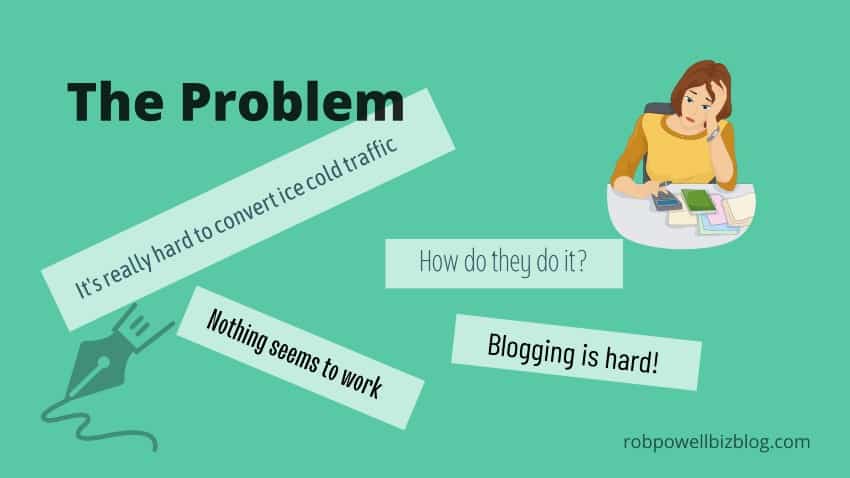
#2. The Problem
The second component of an effective introduction is the problem.
This will be an issue your reader is grappling with: it might be getting ranked on page #1 of the search results, it might be reducing the weekly spend on groceries, or it might be getting rid of acne.
Spend a few sentences elaborating on the problem – the reader has to be vividly aware that this is an issue that’s not going to go away on its own.

#3. The Solution
The third element in a compelling blog intro is the solution.
This is the light at the end of the tunnel. It’s where you tell the reader there’s a remedy for their problem.
You don’t have to go into details at this stage – just let the reader know that your article contains the solution.
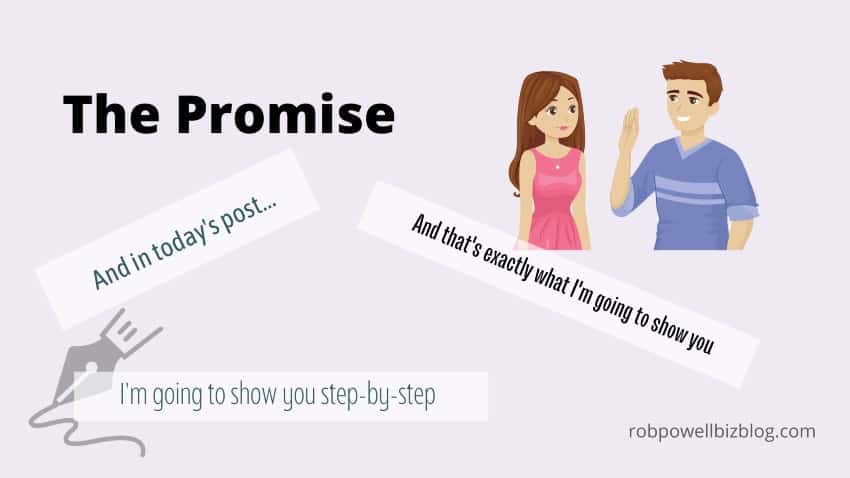
#4. The Promise
The last element in a good intro is the promise.
It usually looks something like this: “And that’s exactly what I’m going to show you in this article” or “And I will show you exactly how to do that using a simple 3-step strategy”.
The promise is what makes your visitor keep reading.
Examples of Good Introductions
So now that we’ve covered the theory of effective introductions, let’s look at some examples in the wild.
In this blog intro, Brian Dean uses short punchy sentences to go straight from the hook, to the problem, the solution, and the promise. It’s a powerful introduction:
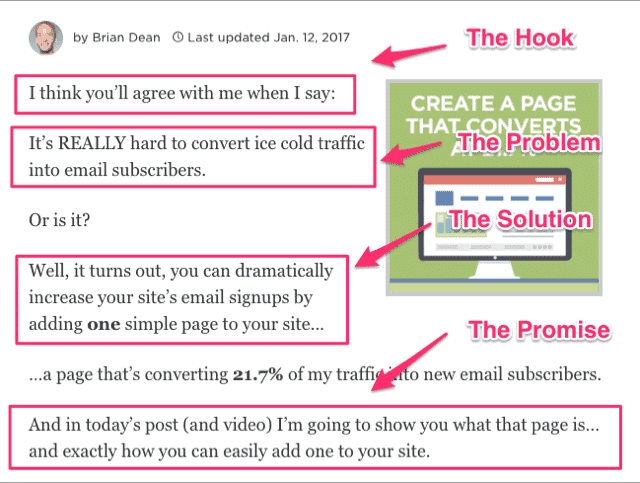
Here’s another great intro by Brian Dean. This time the hook is a question that must be on the mind of everyone who finds his article in the search results.
He elaborates the problem by tapping into a fear we all have: that other people know how to do something that we don’t.
He signals the solution by saying that he’s one of the people who knows how to do it. And he ends with a clear promise of what you will get by reading the article.
Who in their right mind wouldn’t keep reading?
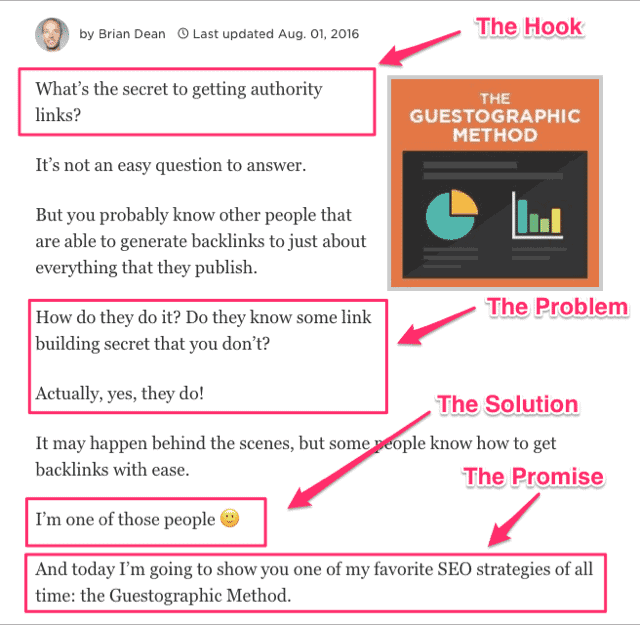
In this intro, Andy Libunao uses the ‘bad news’ hook. He elaborates the problem until you really have no way out.
And then, like a life belt thrown to a drowning man, he tells you there’s a solution and makes the promise.
And naturally, you keep reading:
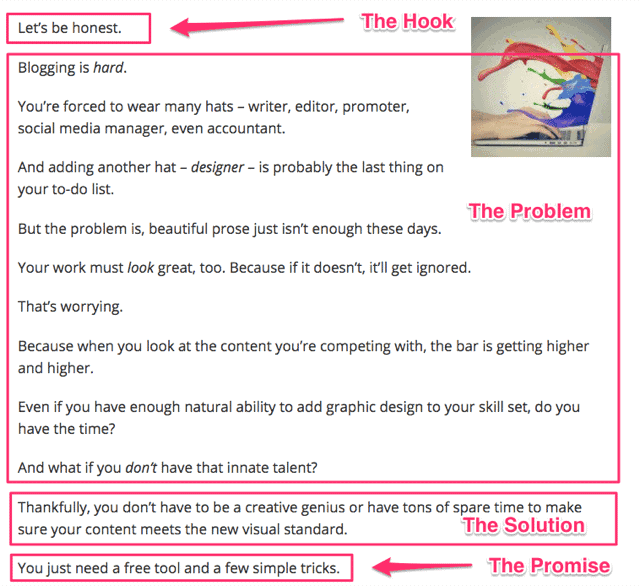
In this blog intro, Katherine Di Cerbo uses a starling question as the hook. She taps into a basic human anxiety: other people are succeeding and you’re not – whatever you do, nothing seems to work.
We’ve all had that feeling, so this intro immediately resonates.
But then, like the first drops of rain hitting parched ground after a long drought, she holds up the solution and then makes the promise.
Of course you’re going to keep reading!
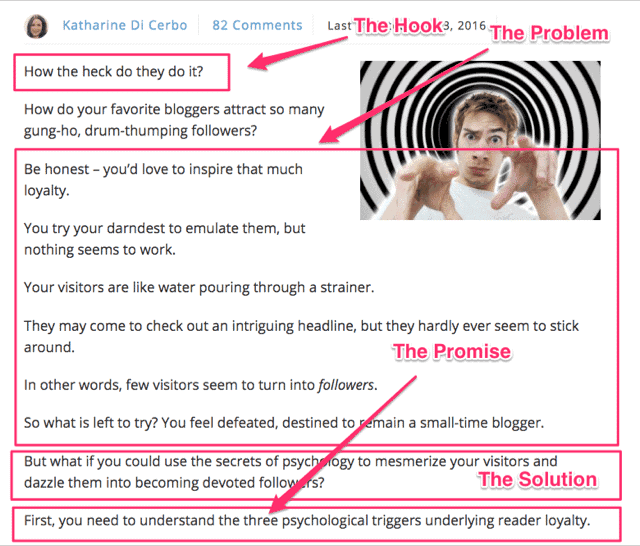
Conclusion
Your blog intro will make or break your blog post. So put some extra time effort into crafting those opening paragraphs.
You need to hook the reader with the first sentence. And in the next few sentences, you need to show that you understand their problem and you have the solution.
Do that, and you’ll turn visitors into avid readers.
Happy writing!
More Articles About Writing
- Best Blog Post Format – 19 Tips for Formatting Online Content
- How To Structure a Blog Post – 13 Elements You Need
- How to Write Your First Blog Post – 17 Tips For Best Results
- How To Write Blog Posts: 10 Best Tips For Ranking on Google
- 21 Great Ideas For Your Next Blog Post
- How To Use Inverted Pyramid Writing for the Web
- How To Write Powerful Titles For Your Blog Posts – The Complete Guide
- Catchy Titles for Articles – 21 Formulas That Work Like Magic
- The 7 Most Effective SEO Copywriting Tools For 2022